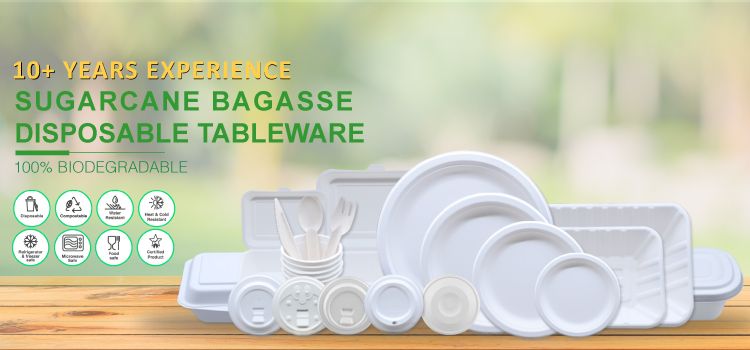Global Leading Automatic
Production Base of Eco Cup Lids
Production Base of Eco Cup Lids
8 Things You Need To Know About Disposable Biodegradable Tableware, I. What are the raw materials used in disposable biodegradable lunch boxes and their respective ratios? 2.How can disposable pulp lunch boxes achieve waterproof and oil-proof effect? 3
With the current global requirements of plastic ban and plastic restriction, plastic-free or biodegradable has become an inevitable trend in the future. The treatment method of ordinary plastic is still incineration and cremation, which causes a large amount of greenhouse gases to be discharged into the air, while disposable biodegradable lunch boxes are buried in the soil for degradation, and the carbon dioxide produced directly enters the soil organic matter or is absorbed by plants, which will not be discharged into the air and will not cause greenhouse effect.
I. What are the raw materials used in disposable biodegradable lunch boxes and their respective ratios?
Conventional lunch boxes are generally made of 70%-90% sugarcane fiber + 10%-30% bamboo pulp fiber. Different tableware will also adjust different fiber ratios according to the shape, angle, hardness and stiffness of the product, and of course, wheat straw, wheat grass, reeds and other plant fibers will be added as needed. All made of plant fiber, no PP, PET and other chemical materials added.
How can disposable pulp lunch boxes achieve waterproof and oil-proof effect?
Pulp molded lunch box will add certain food-grade additives, generally waterproof agent: 1.0%-2.5%, oil-proof agent: 0.5%-0.8%, to achieve the effect of waterproof and oil-proof. Test is generally 100 ℃ water, 120 ℃ oil, test time of 30 minutes; special requirements can be done to extend the oil temperature and test time.
2.How can disposable pulp lunch boxes achieve waterproof and oil-proof effect?
Pulp molded lunch box will add certain food-grade additives, generally waterproof agent: 1.0%-2.5%, oil-proof agent: 0.5%-0.8%, to achieve the effect of waterproof and oil-proof. Test is generally 100 ℃ water, 120 ℃ oil, test time of 30 minutes; special requirements can be done to extend the oil temperature and test time.
3.biodegradable disposable tableware products contain fluorine?
Most of the oil-proofing agents in the vegetable fiber tableware on the market are fluorinated, and the water-proof and oil-proof tableware is fluorine-free.
If you ask the biodegradable tableware does not contain fluorine and waterproof and oil-proof, the better alternative is to laminate, PBAT is currently the most widely used pulp molded environmental tableware, the most used composite materials.
After the lamination of the product can be better insulation, reduce the temperature through the pores of the molded products heat dissipation, while reducing the sticky rice, dumplings and other food, to a large extent, can reduce the use of water repellents and oil repellents.
4. environmental protection pulp tableware how long can be completely degraded?
In the absence of any industrial decomposition machine, pulp molded environmental tableware in the landfill natural state of complete decomposition takes about 45-90 days, no harmful ingredients, no harm to land life and marine coral or marine life.
After degradation, 82% of the composition is organic matter, which can be used as fertilizer for land use, taking natural materials and returning to nature.
5. disposable pulp tableware can be microwave heating and refrigerator refrigeration? What temperature can it reach?
Biodegradable pulp tableware can be microwave heated and oven baked without harmful chemicals, and the maximum temperature can reach 220℃.
It can support refrigerator freezing and freezing up to -18℃.
6. What type of product quality testing standards do the pulp molded lunch boxes meet?
The biodegradable plant fiber lunch box meets the national quality inspection standards of "Pulp Molded Tableware", the U.S. Food and Drug Administration (FDA), the German New Food and Dietetic Products Act (LFGB), and other international standardized inspection standards.
7.Can biodegradable lunch boxes be printed with logos?
Logo can be printed, the printed products are mostly on the circumference, bottom or top of the lunch box products, cups, bowls and other products are mostly printed on the outside of the products and need to use curved surface printing. According to the printing equipment is divided into screen printing, pad printing and laser laser printing (jet code printing).
Printing products will correspondingly increase the cost of products.
8. Are the raw materials used in white biodegradable lunch boxes bleached? What bleaching agent is used?
Unbleached vegetable fiber pulp contains a small amount of lignin and colored impurities, so it is yellow in color and the fiber is hard. Semi-bleached pulp contains a large amount of polypentose and has a light yellow color, commonly known as natural color. Bleached pulp has white fibers and a pure and soft texture, but the fiber strength is lower than unbleached pulp due to the bleaching treatment.
Bleach generally uses hydrogen peroxide bleach, not chlorine bleach!

